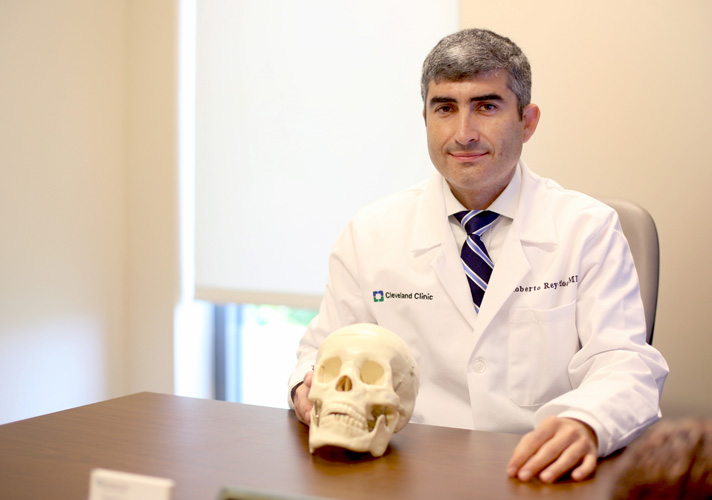
Newly arrived Cleveland Clinic Indian River Hospital neurosurgeon and neurosurgical oncologist Dr. Roberto Rey Dios faces a daunting set of numbers every day.
An estimated 700,000 people in the United States are living with a primary brain tumor – one that originates in the brain – and over 87,000 more will be diagnosed this year alone. But that’s far from the end of that story.
Metastatic brain cancers – or cancers that spread from other parts of the body to the brain – add significantly to overall brain tumor numbers.
Rey Dios knows all too well that puts Vero’s largest population segment at greater risk for brain tumors.
“The population in this area,” says Rey Dios, “is an aging population. So, most of our patients are going to be on the older side and we’re going to see a lot of age-related tumors – meaning we’re going to see a lot of people with metastasis.
“Many people get cancer. Let’s say they’ve got breast cancer or colon cancer or other cancers. Eventually [those cancers] can spread into the brain. Those tumors implant themselves in there, so we see more of glioblastoma or malignant tumors of the brain cells.”
It’s here where Rey Dios shoots down one popular cancer myth.
Generally, all tumors, including those inside the brain or skull, are designated as either being ‘benign’ or ‘malignant,’ but Rey Dios cautions that ‘benign’ doesn’t necessarily mean ‘harmless.’
“The reality,” says the soft-spoken Rey Dios, “is this: A lot of [brain] tumors are really benign, that is, they have no cancer, but because of their location they can cause a lot of damage and they’re difficult to treat because they are not easily accessible.
“And then on the other side of the spectrum, you have the actual malignant brain tumors that come from elsewhere [in the body].”
The Mayo Clinic says “in adults, primary brain tumors are much less common than are secondary brain tumors, in which cancer begins elsewhere and spreads to the brain.”
The good news is that treating or removing brain tumors today is much more precise and sometimes even makes the old-school ‘craniotomies’ – cutting sizable sections of the skull away and surgically taking the tumors out – seem downright medieval.
Now, Rey Dios explains, “we can use natural openings in the head, like the nose and the mouth, which we can go through to get to underneath the brain and remove tumors. We can do endoscopy, which means instead of opening the entire skull, [we] just do a small hole, put a camera inside and deal with a tumor like that.
“We can [also] do laser ablations in which we do a tiny, tiny hole in the skull and put in a laser probe and we can disintegrate the tumor like that. And we can do radio surgery, in which we use very high-energy radiation” to kill the tumor.
“And we can concentrate on one spot in the tumor and treat it without ever opening the skull,” Rey Dios added.
When pressed as to whether there are certain tumors he doesn’t look forward to treating, Rey Dios offers a candid reply.
“Certainly. I mean, there are tumors like that, especially when we talk about these malignant tumors, these glioblastomas or high-grade glioma tumors. It is very un-rewarding [to treat those] because I know that even if it was a great surgery and we removed all the tumor that we can see, the prognosis is still very poor.”
The National Brain Tumor Society reports that those glioblastomas are the most commonly occurring primary malignant brain tumors, accounting for 14.6 percent of all tumors and nearly half of all malignant tumors.
Catching glioblastomas – or any cancer – as early as possible is vital to successful treatment, but that can be a challenge because the symptoms are various and may be oblique.
Those symptoms can include headaches, seizures, nausea or vomiting, fatigue, drowsiness, sleep or memory problems, and vision problems.
As Rey Dios points out, “in my previous practice, my main source of referrals for pituitary tumors were ophthalmologists and the endocrinologist.”
If you are experiencing any of the above symptoms it might be wise to talk to your primary care physician.
Depending on your age and medical history, he or she might order imaging tests to rule out or confirm a problem that requires immediate intervention.
After all, as Massachusetts General Hospital and the Harvard Medical School say, “today’s neurosurgeons treat brain tumors, brain aneurysms, pituitary gland tumors and more through functional neurosurgery, interventional neurosurgery and proton beam neurosurgery.”
They are, in colloquial terms, ‘locked and loaded’ and ready to help.
Dr. Roberto Rey Dios is a neurosurgeon and neurological oncologist at the Cleveland Clinic Indian River Hospital. His office is at the hospital’s Health & Wellness Building at 3450 11th Court, Suite 305. The phone number is 772-563-4741.



